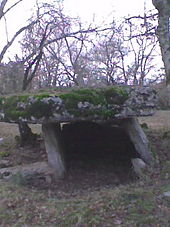Issendolus
|
Issendolus Aissendolús |
||
|---|---|---|
|
|
||
| region | Occitania | |
| Department | Lot | |
| Arrondissement | Figeac | |
| Canton | Gramat | |
| Community association | Grand Figeac | |
| Coordinates | 44 ° 45 ' N , 1 ° 47' E | |
| height | 300–373 m | |
| surface | 18.91 km 2 | |
| Residents | 516 (January 1, 2017) | |
| Population density | 27 inhabitants / km 2 | |
| Post Code | 46500 | |
| INSEE code | 46132 | |
 Issendolus - the site |
||
Issendolus ( Occitan : Aissendolús ) is a southern French municipality with 516 inhabitants (as of January 1, 2017) in the Lot department in the Occitania region . Issendolus is part of the Causses du Quercy Regional Nature Park .
location
Issendolus lies at an altitude of approx. 350 meters above sea level. d. M. on the southwestern edge of the Massif Central, roughly on the border between the fertile Limargue region and the very different limestone soils of the Ségala . The place is located on a branch of the Way of St. James ( Via Podiensis ) about halfway between Rocamadour or Gramat and Figeac ; the city of Cahors is about 63 kilometers southwest.
Population development
| year | 1962 | 1968 | 1975 | 1982 | 1990 | 1999 | 2006 |
| Residents | 346 | 342 | 334 | 397 | 365 | 454 | 520 |
In the 19th century the place had more than 1000 inhabitants at times. As a result of the phylloxera crisis in viticulture and the mechanization of agriculture , the population has since declined to the lows in the 1960s and 1970s.
economy
In the Haut-Quercy , agriculture, which included viticulture until the 19th century, was primarily self-sufficient for centuries . After the phylloxera crisis in the second half of the 19th century, viticulture in the region was almost completely given up. Today - in addition to agriculture, retail and handicrafts - tourism in the form of renting holiday apartments ( gîtes ) plays a major role in the economic life of the municipality.
history
The early history of the place is closely linked to a pilgrims' hospice founded in the 13th century, which was repeatedly damaged or destroyed during the Hundred Years War (1337-1453) and the Huguenot Wars (1562-1598).
After the Allied invasion in June 1944, the SS division 'Das Reich' destroyed barns and buildings in the hamlet of Gabaudet and massacred the population.
Attractions
- Two Neolithic large stone graves ( dolmen ) are located about four kilometers southwest of the village in the area of Domaine Gabaudet . They were classified as Monuments historiques in 1931 .
- Another dolmen ( Pierre Levée ) is about 2500 meters west of the village. It has also been recognized as a Monument historique since 1988 .
- The pilgrim hospital ( Couvent de l'Hôpital-Beaulieu ) founded in the early 13th century was directed by the Order of St. John . After extensive destruction, the reconstruction began in 1608 - a new church was built and the building complex was surrounded by a 715 meter long and up to seven meter high wall. Now up to 80 religious sisters served the sick and dying. In February 1793, the buildings were sold as a national property ( bien national ) and demolished. Only a few remains of the chapter house and the monastery walls are reminiscent of the hospital, which was once known far beyond the region and was recognized as a monument historique in 1921 .
- The eastern parts ( apse , crossing ) of the parish church ( Saint-Julien ) are still Romanesque ; the nave was extended to three naves in the 18th century. Despite the different construction phases, the interior of the church radiates great harmony.
- There are over 100 large stone graves , field stone huts ( caselles ), wayside crosses, etc. in the municipality , which can be explored on various hikes.
Web links
- Issendolus - compilation of sights (French)
- Issendolus - Photos
- Issendolus, church - photos + information (in French)
- Issendolus, church - photo
Individual evidence
- ↑ Dolmens du Gabaudet, Issendolus in the Base Mérimée of the French Ministry of Culture (French)
- ^ Dolmen Pierre Levée, Issendolus in the Base Mérimée of the French Ministry of Culture (French)
- ↑ Ancien hôpital des Religieuses de Beaulieu, Issendolus in the Base Mérimée of the French Ministry of Culture (French)



